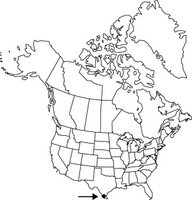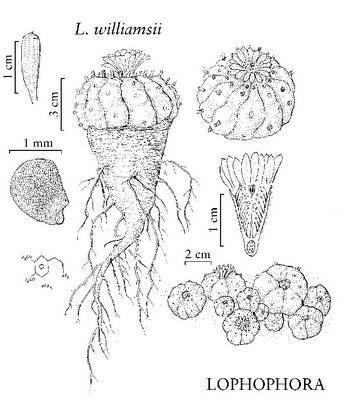Lemaire, Cact. Gen. Sp. Nov. 3. 1839.
[Greek asteros, star, in reference to the star-shaped stem cross section of the type species, and phyton, plant]
Allan D. Zimmerman & Bruce D. Parfitt
Plants stem succulents, unbranched [to several branched from base], mostly low and deep-seated in substrate [taller in Mexican species]. Roots diffuse. Stem unsegmented, dark green or gray-green, hemispheric or depressed-spheric [to spheric or short cylindric], (2.5-)6-15(-60)[-100] × 6-10(-20) cm, speckled [or entirely hidden] by numerous tufts of dense, whitish, multicellular hairs less than 0.5 mm; ribs [4-]8-10, crests uninterrupted, straight [to sinuous and/or helically curving around stem], broad and nearly flat or rounded [sharp or keeled]; areoles distinct, [2-]6-9[-20] mm apart along ribs, circular; areolar glands absent; cortex and pith hard, not mucilaginous. Spines absent [1-25 per areole in some Mexican species]. Flowers diurnal, near stem apex, at adaxial edge of areoles, funnelform, 4.5-5.4[-8] × 3.8-5.2[-6] cm; inner tepals yellow, proximally red [all yellow], 25 × 6-10[-12] mm, margins entire; ovary sparsely to densely scaly, axils spineless long hairy with arachnoid trichomes, distal scales spine-tipped; stigma lobes [8-]10-12, yellow [pale yellowish], 4 mm. Fruits indehiscent or splitting irregularly, green or pinkish to red, ovoid to spheric, 15-20 × 12 mm, initially fleshy, drying immediately after ripening, sparsely to densely scaly with spine-tipped scales; axils of scales long woolly, spineless; floral remnant persistent. Seeds dark brown to blackish, appearing hollow or bowl-shaped from strongly expanded, inrolled rim around sunken hilum, 2-3 mm in greatest dimension, nearly smooth; testa cells very slightly convex. x = 11.
Species 4-5 (1 in the flora): sw United States, Mexico.
Astrophytum is most often recognized as a distinct genus. Chloroplast DNA evidence (C. A. Butterworth et al. 2002), however, confirms that it is among the closest relatives of Echinocactus. Unlike Echinocactus, the stem surfaces of Astrophytum species are speckled by numerous tiny white tufts of minute, matted hairs in addition to the regularly spaced woolly areoles.
1. Astrophytum asterias (Zuccarini) Lemaire, Cactées. 50. 1868.
Star-peyote, star cactus, sea-urchin cactus
 Echinocactus asterias Zuccarini, Abh. Math.-Phys. Cl. Königl. Bayer. Akad. Wiss. 4(2): 13. 1845
Echinocactus asterias Zuccarini, Abh. Math.-Phys. Cl. Königl. Bayer. Akad. Wiss. 4(2): 13. 1845
Plants flat-topped and usually flush with soil surface, or at most, above-ground portion low, dome-shaped. Stems shiny, sparsely speckled by bright white extra-areolar hair tufts 0.5-1 mm diam.; ribs usually 8, straight, very low, nearly flat or rounded; areoles 3-5 mm diam., with yellow or gray wool. Flowers opening widely, externally long woolly; inner tepals lanceolate, acuminate. 2n = 22.
Flowering Mar-May and sporadically after summer rainfall. Grasslands, shrublands, Tamaulipan thorn scrub, gravelly slopes and deep soil of flats; of conservation concern; 20-100 m; Tex.; Mexico (Nuevo León, Tamaulipas).
The vernacular name of Astrophytum asterias, star-peyote, reflects its superficial similarity to peyote, Lophophora williamsii, which has very soft, uniformly pale blue-green stems quite unlike the hard, speckled, almost shiny, green stem surface in A. asterias. Astrophytum asterias is extremely rare and localized north of Mexico, presently known only from Starr County, Texas.

Back to online articles.
The Flora of North America web site.






















